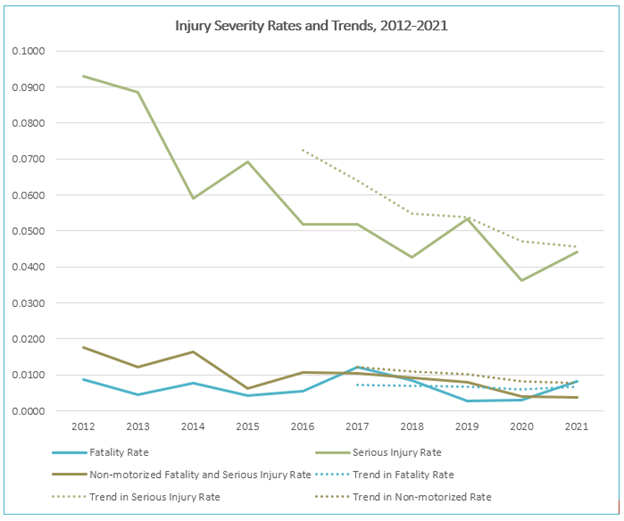
Safety Performance Measures for the Highway Safety Improvement Program (HSIP)

The Highway Safety Improvement Program (HSIP) is a Federal-aid program designed to reduce traffic fatalities and serious injuries on all public roads, including non-State-owned roads and roads on tribal land.
Every state department of transportation (DOT) is required to submit to the Federal Highway Administration (FHWA) a Highway Safety Improvement Program annual report that:
- Describes the progress being made to implement highway safety improvement projects;
- Assesses the effectiveness of those improvements; and,
- Describes the extent to which the improvements have contributed to reducing fatalities and serious injuries on all public roads.
The safety performance analysis in the report describes the state trends in the federal safety performance measures (and others if desired), established targets, the basis for the targets, and how the targets support the State’s Strategic Highway Safety Plan (SHSP) goals. The FHWA evaluates the state HSIP reports and determines that a State DOT has met or made significant progress toward meeting its safety performance targets when at least four of the targets have been met or the actual outcome is better than the baseline performance. If FHWA determines that a State DOT has not met its targets then the State DOT must obligate the HSIP funds apportioned in the previous year to only HSIP projects and submit a HSIP implementation plan.
State Targets
WisDOT has developed targets with the goal of reducing crashes in all measures by 2%. The baseline for 2024 targets is the 5-year average for 2018-2022.
WisDOT Highway Safety Improvement Program Performance Targets, 2024
| Safety Performance Measure | 2018-2022 Baseline | 2024 |
| Fatalities: Number of fatalities | 600.8 | 588.8 |
| Fatality Rate: Fatalities per 100 million vehicle miles traveled | 0.934 | 0.915 |
| Serious Injuries: Number of serious injuries | 3,095.6 | 3,033.7 |
| Serious Injury Rate: Serious injuries per 100 million vehicle miles traveled | 4.822 | 4.726 |
| Non-motorized Fatalities and Serious Injuries: Number of non-motorized fatalities and non-motorized serious injuries | 379.4 | 371.8 |
| Source: Wisconsin Department of Transportation. | ||
The 2024 MnDOT targets were established based on a trend from the 2019 outcome to the Strategic Highway Safety Plan goal for 2025 of no more than 225 traffic deaths and 980 serious injuries.
MnDOT Highway Safety Improvement Program Performance Targets, 2024
| Safety Performance Measure | 2018-2022 Baseline | 2024 |
|---|---|---|
| Fatalities: Number of fatalities | 414.2 | 352.4 |
| Fatality Rate: Fatalities per 100 million vehicle miles traveled | 0.725 | 0.582 |
| Serious Injuries: Number of serious injuries | 1,676.2 | 1,463.4 |
| Serious Injury Rate: Serious injuries per 100 million vehicle miles traveled | 2.930 | 2.470 |
| Non-motorized Fatalities and Serious Injuries: Number of non-motorized fatalities and non-motorized serious injuries | 282.4 | 258.4 |
| Source: Minnesota Department of Transportation. | ||
Local Performance
Fatalities in the planning area in 2021 (9) were up 122% from the 5-year average for 2017-2021 (7.4), while serious injuries in 2021 (49) was nearly the same as the 5-year average (49.4). In 2020, the planning area experienced its lowest total of non-motorized fatalities and serious injuries (4) since before 2010.
This increased in 2021 to a total of (10) non-motorized fatalities and serious injuries and is above the 5-year average (8.8) by 114%.
The rate (number of occurrences per million vehicle miles traveled) for fatalities, serious injuries, and non-motorized fatalities and non-motorized serious injuries for 2012-2021 are shown in the graph below along with the trends in the moving averages from 2017-2021. From 2012-2016 to 2017-2021, the 5-year averages for the serious injury and non-motorized rates declined 51.2% and 60.7%, respectively.

Figure: Injury severity rates and trends, 2012-2021. Rates are calculated using MPA totals and La Crosse County VMT. Data sources: TOPS Lab, UW-Madison, WisDOT and MnDOT websites.
Note: The safety discussion for the planning area was not updated to a baseline of 2018-2022 because vehicle miles traveled in Wisconsin is not available for 2022.
Community Maps

If you want to learn more about crashes in the region and in the state, please visit Community Maps. This tool is hosted at the University of Wisconsin-Madison by the Wisconsin Traffic Operations and Safety (TOPS) Laboratory in collaboration with the Wisconsin Department of Transportation (WisDOT).

